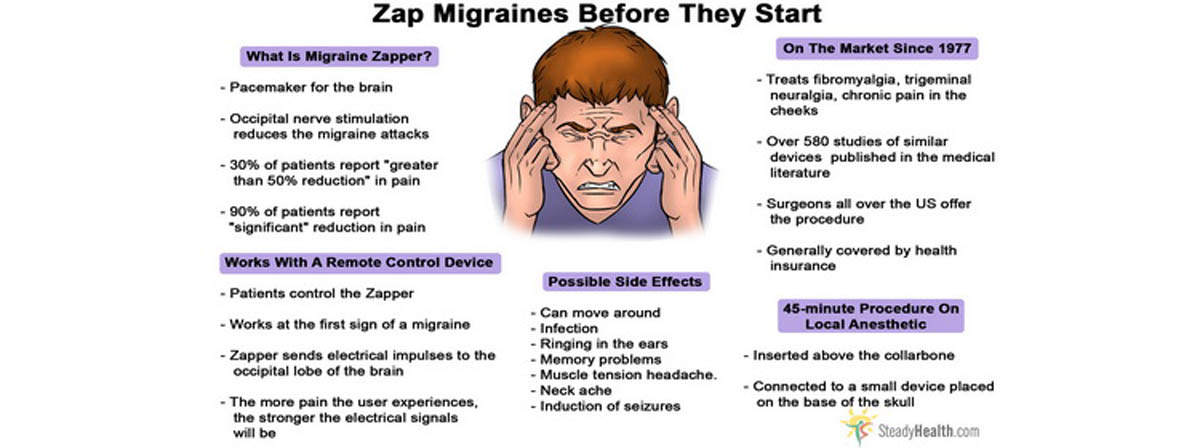There isn't any pain quite like the pain of migraine headaches. Often signaled by a sudden change in vision, such as blurry vision, blindness on one side of the field vision, or an aura that makes the whole world look like you are looking through a kaleidoscope, migraines usually come with a variety of disagreeable symptoms.

Some people who get migraines, however, experience no pain at all. Typically, women who get migraines have more pain and fewer symptoms of visual distortion, and men who get migraines have less pain but more visual distortions. Along with headache, the condition often causes nausea, vomiting, and feelings of anxiety or anger or despair. Light and sound become intensely painful, so that the migraine sufferer just wants to find a dark, quiet place to curl up until it's over. Some migraine sufferers experience two or three migraine attacks every day. There are even some people who essentially have migraines all the time, and who are basically disabled by the condition.
But neurosurgeon Dr. Brian Snyder of Winthrop-University Hospital on Long Island, New York has been able to give some of his patients complete relief from migraine by surgical implantation of a pacemaker not for the heart but for the brain. This remarkable device looks like and runs like a pacemaker for the heart. It is just connected to different nerves, at the base of the skull rather than at the tip of the heart.
How the Migraine Zapper Works
The pacemaker for migraines is inserted just above the collarbone like a pacemaker for the heart. It is connected to a small device placed on the base of the skull, where the occipital nerves, the nerves that send the brain information from the eyes, enter the brain.
There is a brief stay in post-op and most patients go home the next day. There is some pain and soreness where the pacemaker is placed in the chest, and occasionally there can be bleeding. Dr. Snyder usually does the surgery in two parts, first giving his patients a temporary pacemaker to make sure the procedure works, and then implanting the pacemaker permanently.
Get Rid of Migraines By Remote Control
Unlike a cardiac pacemaker, the brain pacemaker isn't in operation all the time. Patients carry a remote control device that turns on the pacemaker so it can send electrical impulses to the occipital lobe of the brain at the first sign of a migraine. The more pain the user experiences, the stronger the electrical signals will be. This process of occipital nerve stimulation is thought to reduce the severity and frequency of migraine attacks.
This technique is also used to treat fibromyalgia and trigeminal neuralgia, chronic pain in the cheeks of the face. Similar devices have been around since 1977, and there are over 580 studies of them published in the medical literature.
How Well Do Migraine Zappers Work?
Most people who have migraines take medications to try to prevent or relieve migraine attacks. The problem with medications is that they cause significant side effects.

- Anti-seizure drugs, such as valproate sodium (Depacon, Depakote, Depakeen) and topiramate (Topamax) may reduce the severity and frequency of migraine attacks but they also cause weight gain, mood swings, and liver damage.
- Beta-blockers, used to prevent migraines and also used to control high blood pressure, racing heart (tachycardia), and muscle tremors (many professional pool players take beta-blockers), can cause asthma and depression.
- ACE-inhibitors, likewise used to prevent migraines and to control high blood pressure, such as the antihypertensive drug lisinopril (Zestril), sometimes trigger persistent dry cough that just won't go away.
- Calcium channel blockers, used to fight high blood pressure and also to keep blood vessels from becoming too narrow or too wide, reduce the severity of migraines but increase risk of heart attack. They also cause severe constipation in most users.
- Aspirin taken on a regular basis may stop the frequency and severity of migraine attacks, but it also can cause stomach upset and hearing loss.
- Some of the older antidepressants, such as amytriptyline (Elavil), which costs just $4 a month even without a subsidy, help prevent migraine attacks, but they can cause severe high blood pressure when taken at the same time certain foods are eaten.
- "Rescue medications" such as almotriptan (Axert), eletriptan (Relpax), Frovatriptan (Frova), naratriptan (Amerge), rizatriptan (Maxalt), sumatriptan (Imitrex), and zolmitriptan (Zomig) relieve pain but can actually aggravate nausea and vomiting. People who have had or who are at risk for heart attacks and strokes can't take them.
- Herbal medications for preventing migraines, such as butterbur (also known as Petasites) and feverfew, are genuinely effective, but they present some of the same side effects as Aspirin.
So if you can't find a drug that works well, and many people who have migraines can't, you might prefer to see a doctor about getting a migraine zapper.
However, that technology isn't perfect, either.
- The leads from the pacemaker to the base of the skull can move around. Additional surgery may be necessary to put them back in place. This happens in up to 42% of cases for some kinds of pacemaker surgery for migraine.
- The surgery can cause infection, especially when the pacemaker is inserted in an alternative location, such as the buttocks. This happens up to 14% of the time.
- And the zapper doesn't completely eliminate migraines. Only about 1/3 of patients report "greater than 50% reduction" in their pain. However, about 90% of migraine sufferers receiving the device report "significant" reduction in pain.
Occipital nerve stimulation isn't a miracle for migraines, but if nothing else works for you, you may want to try it. Surgeons all over the United States offer the procedure, and it is generally covered by health insurance.
- Palmisani S, Al-Kaisy A, Arcioni R, Smith T, Negro A, Lambru G, Bandikatla V, Carson E, Martelletti P. A six year retrospective review of occipital nerve stimulation practice - controversies and challenges of an emerging technique for treating refractory headache syndromes. J Headache Pain. 2013 Aug 6.14(1):67. doi: 10.1186/1129-2377-14-67.
- Mindmap by steadyhealth.com
- Photo courtesy of Doug Belshaw by Flickr : www.flickr.com/photos/dougbelshaw/3997992481/


Your thoughts on this